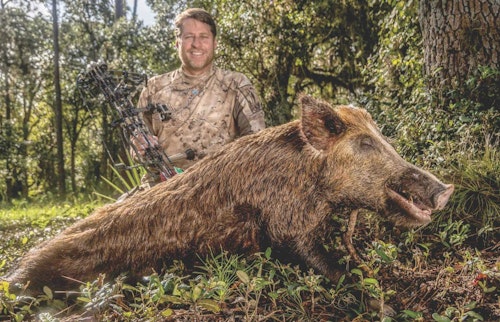
FMJ arrow’s small-diameter and heavyweight configuration combined with the SEVR broadhead’s no-nonsense design proved the point — even low-poundage bows can rule the day with the proper arrow and broadhead combination.
Recently, a friend asked me if I would like to accompany him on a hog hunt.
“Am I breathing?” I replied.
So far, my spring had been consumed with mundane chores of lawn care and battling the ever-encroaching autumn olive bushes on my property, punctuated by infrequent opportunities to pursue wild turkeys. I was already bored to tears. I probably would have agreed to a snipe hunt, if someone had asked.
“Where are we going?” I questioned, feeling that familiar excitement building in my chest at the prospects of a hunt.
“Just outside Melbourne, Florida — Osceola Outfitters — at the end of August,” my friend responded.
“I’m in,” I said flatly, tropical temperatures, sweltering humidity and Jurassic-sized mosquitos be damned. Besides, I had new gear for the upcoming bow season, and this would give me the chance to prove their mettle before hitting the deer stands. After all, benchtop racing and foam targets can only take you so far. To know what’s really going on, you need a shakedown test — a real-world evaluation of what works, what doesn’t and what should be tweaked before game day.
I had set two goals for myself for the impending archery season: First, work up an old school recurve outfit. And second, dust off my compound bow, which had been dormant for the last several years. Are you confused by my diametrically opposed goals? If so, it’s understandable.
Like many veteran bowhunters, I get almost as much joy from the gear I’m hunting with as I do from the harvest. While many bowhunters see gear as the means to an end, I approach equipment as an inseparable element of the chase — something beyond delivering a broadhead to the target.
One’s choice in hunting gear shapes the overall hunting experience; each item adds nuance, challenge, enjoyment or all-of-the-above by virtue of its design and performance capabilities. In other words, the gear we choose defines the hunt and what we get out of it.
For example, when my state legalized crossbow hunting a few years ago, I decided to get one. I liked it. As a ground hunter (I get woozy in treestands), the crossbow let me set up ambushes I could never get away with while using a vertical bow — tight holes carved out of tangled brush, low ditches in open fields and point-blank setups along thick travel routes. Essentially, the gear adds new dimensions that spice up my hunting experiences.

Last year, however, I heard the call of my forlorn Bowtech hanging in my shop. I had not picked it up since acquiring the crossbow, using instead my recurve for a challenge and the crossbow to fill the freezer reliably. So, when my buddy floated the notion of a summer hog hunt, the weapon choice was easy.
Seeking an Ideal Arrow
I’m a miserly sort, so most things must be falling apart before I spend money on replacements. That was the case with my compound. I got it new from a buddy for an absolute steal, with one glaring caveat: it maxed out at 53 pounds. Nevertheless, I’ve dropped plenty of deer with it over the years and figured it was good for many more. The impending hog hunt made me think seriously about how to extract the most performance from it.
Bowhunting with traditional gear teaches two significant lessons. First, shot placement rules the day. This, of course, goes for any shooting sport. It is our duty as ethical hunters to execute lethal shots every time we release the string. Second, penetration is the final arbiter of success. If your setup cannot reliably smash through bone to reach vital organs and — optimally — exit the other side to promote maximum blood loss, you might want to rethink your equipment strategy.
Only twice did my relatively lightweight compound ever fail to achieve pass-through shots. That’s because I rarely take anything but a perfectly broadside shot on a deer — one that will take out both lungs while leaving the shoulders unscathed. That means passing on otherwise acceptable shots; it also means I spend more time dragging deer than tracking them.
Bowhunting for hogs, though, changes the game. Unlike deer, a broadside, shoulder line shot on a hog delivers an arrow through the gut since their vitals are tucked forward of the shoulder crease. This means you need either a quartering-away shot so your arrow can zip into the boiler room, or an arrow and broadhead combination with the grit to penetrate the shoulder and its thick, protective shield.
Although speed is a key variable in the kinetic energy formula, mass (or weight) is at least equally as important, maybe even more important. With a bow’s stored energy essentially fixed, we must look to the arrow for the optimal balance of speed and mass to produce the downrange energy needed for maximum penetration.
Studious bowhunters today are keying in on something traditional bowhunters have known for years — a heavy arrow may not sizzle a chronograph, but it carries a massive punch that settles all debts between hunter and prey.
Another factor that marginally affects arrow speed and kinetic energy is an arrow’s diameter. What’s easier to push through a hay bale, a ball bat or a pencil? An exaggeration, perhaps, but you get the idea. A small-diameter arrow, having less surface area, will exhibit less drag as it passes through an animal — especially if that diameter is less than that of the broadhead ferrule.
The carbon arrows I had been shooting had a hunting weight of 409 grains. Looking for something heavier and of a smaller diameter, I homed in on Easton’s FMJs. These are carbon core arrows with an aluminum jacket. The carbon core provides the strength and precision in a small diameter, while the aluminum jacket adds weight and a super-slick finish with a low friction coefficient to better slip through hide, muscle and organs.
Working the math, I calculated that, with my draw length, a 5mm FMJ arrow fitted with Easton’s Brass X HIT insert and a 100-grain broadhead should put me around 100 grains over the weight of my old full-length carbons, while delivering a friction advantage courtesy of the aluminum jacket. After trimming off a couple inches, the FMJs weighed 506.9 grains, a hefty projectile to be sure, and a solid 98.3 grains more than the old arrows.
On the target range, the weight gain showed itself immediately as the distance grew between my pins. Although the arrow drop was noticeable, so too was the deeper penetration into the target and the slightly quieter shots as more of the bow’s energy transferred to the arrow instead of being wasted on vibration.
But, how would it punch a pig?

Getting on Point
As a traditional-leaning bowhunter, I tend to raise eyebrows at complicated broadhead designs — especially those that seem over-engineered simply to bring a “new and better” mousetrap to market. The archery landscape is littered with the corpses of such designs. When I got a sneak peek at the new SEVR two-blade mechanical head early last year, no such thoughts entered my head. The SEVR exuded wicked simplicity, and I knew I had to try it.
Based on the Ulmer Edge originally developed by bowhunting great Randy Ulmer, the SEVR is constructed of a solid-piece titanium ferrule with a four-edged cut-on-contact point that means business. The rear-deploying blades are secured by a set screw located high on the ferrule and are held closed during flight with a rubber ring at the ferrule base. With the blades’ trip ends positioned prominently just behind the point, the SEVR looked to me as if deployment would not be an issue. When deployed, the blades present a massive 2.1-inch cutting diameter.
The impressive trick up the SEVR’s sleeve, though, is its locking and pivoting blade design. When fully deployed, the heels of the blades lock together in a simple overlap joint, letting them function as a single unit. This allows the blades to swivel in unison on their common pivot point. The advantage to this design is that the now-unitized blade assembly can pivot away from hard bone without seriously disrupting the straight-line trajectory of the arrow as it passes through the animal. Once past the obstruction, the blade assembly can re-center itself relative to the ferrule as it continues its path.
Again, the question: How would it punch a pig?
The Great Tusker Trials
Whitetail bowhunters have many options to take “offseason” trips — from spring turkey, summer small game and predators, to big-game exotics on ranches found across the state of Texas and wild hogs throughout the South. Any of these provide an invaluable means of evaluating new gear before the fall seasons start — everything from the arrows and broadheads we planned to test down to smaller essentials like binos, knives and packs. Packs, in particular, benefit from shakedown tests. What looks and feels good in the store may be more of a nightmare once loaded with gear and you’re three miles into the bush. That is the value of a pre-season bowhunting trip — a means to evaluate gear in a low-key, fun, no-serious-consequences manner.
Upon arrival at Osceola Outfitters, we flopped our gear bags into our bunkrooms and immediately broke out the bows to make sure our zeros survived the flight. There was a mix of compounds and crossbows in our group, and everyone spent a few rounds on the targets. Since we had all switched over to the FMJ arrows and SEVR broadheads for the hunt, this would provide an ideal test with hard evidence for or against the merits of this combination before we scattered across the country in a couple months on our individual pursuit of elk, deer, muleys and pronghorns.

When our 3-day hunt ended, the tally sitting in the Osceola Outfitters meat locker told the tale — we all had pork in the freezer, having taken hogs from 30 to 40 yards, as well as one dog-bayed bruiser at point blank range. In each instance, the SEVR broadheads fully deployed and got the job done. Some delivered pass-through shots through both shoulder shields; some were abruptly halted on far-side bone, but the FMJ shafts seemed to carry the momentum we were hoping for and the SEVR heads performed their jobs flawlessly.
All broadheads were recovered to fight another day, except for one of mine. I plugged a boar at 20 yards and the FMJ pushed the SEVR broadhead through the left shield, burying it ferrule-deep into the spine. The hog was done for, as was the broadhead — interred in the spine for eternity.
One aspect of the FMJ/SEVR combo that I subjectively contribute to the lethal performance we witnessed on this trip is the slightly smaller shaft diameter relative to the broadhead ferrule. This configuration seems to deliver above-average penetration because the wider ferrule effectively clears a less-restrictive channel for the arrow to follow, thus reducing friction and allowing the arrow to retain marginally more kinetic energy as it pushes through an animal. For tough game such as elk, bear or moose, that’s exactly what we’re after.
For many bowhunters, 3-D shooting provides us with the “fix” we need to see us through the offseason. Although we’ll never give that up, there is nothing more fun than a relaxed, offseason bowhunt with your buddies to give your gear a proper field evaluation and to determine what works and what doesn’t before the big day arrives.







